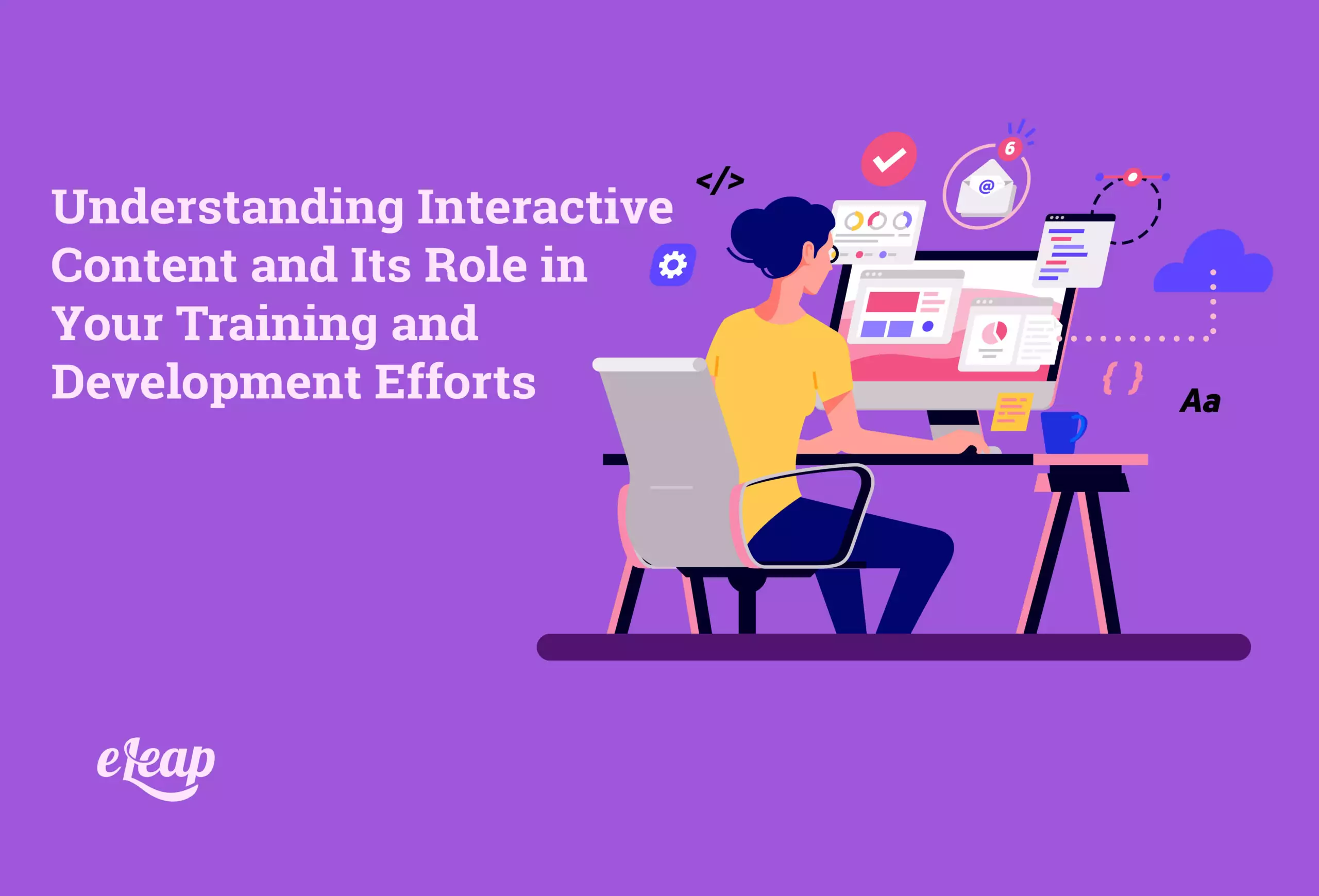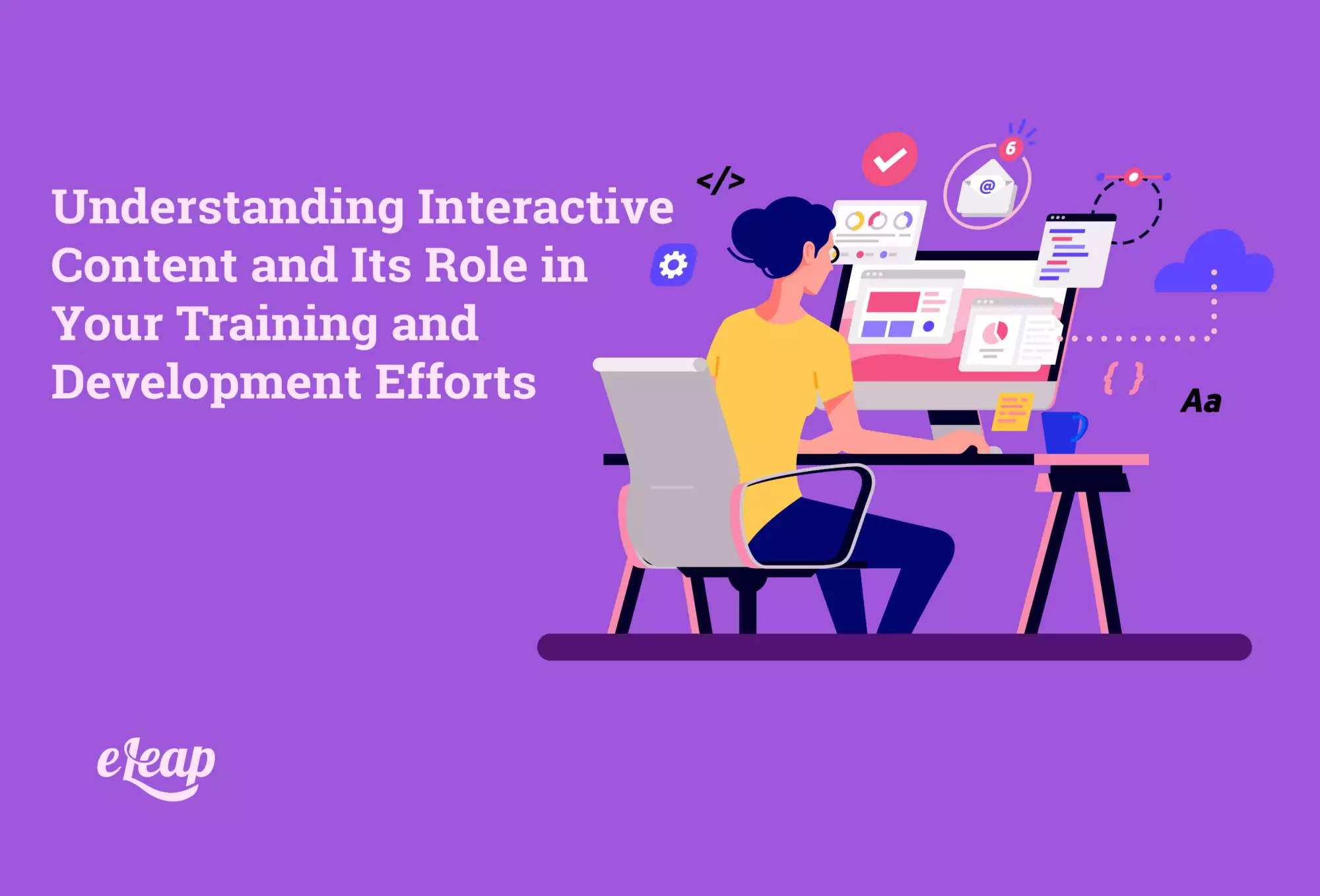Understanding Interactive Content and Its Role in Your Training and Development Efforts

Interactive content is touted as being the solution for all that ails your training and development efforts. It’s supposed to boost engagement, improve completion scores, and ensure better knowledge retention. However, for all that, it’s poorly understood within some organizations.
What is it? What does “interactive” really mean? We’ll address those questions and more within this guide.

What Is Interactive Content?
Interactive content is, well, content that requires the learner to interact in some way. It’s about turning learning from a passive activity into an active one. The learner must engage with the course content in some way, which makes them an active participant.
You can think of it more like a two-way flow of information between the lesson and the learner if that helps. Think of social media – a brand you follow makes a post and you comment on it. The brand then replies, creating interactivity and a two-way flow of information. It’s engaging in a way that simply reading the post could never be.
Exploring the Benefits of Interactive Content
Why bother retooling your L&D strategy to ensure it includes interactive content? Simply put, the dangers of not doing so are too great. The benefits offered by blending this content in with other types far outweigh the costs and time constraints of doing so. What are those benefits, though? Here’s a quick rundown:
- Emotional Triggers: Learning should not be an emotional void. It should be enjoyable, engaging, uplifting – things that can only be achieved when you trigger your learners’ emotions. That can be done through evocatively told stories and scenarios, animation, games, and so much more.
- Strengthen Decision-Making: Remember that two-way flow of information we talked about? It’s good for more than just engagement. It can also strengthen decision-making skills and build confidence in your learners. Imagine if employees emerged from a course empowered and emboldened to make decisions based on new knowledge!
- Improved Engagement: Engagement is one of those often-touted but poorly understood metrics, and that’s largely because it can’t be measured directly. However, it can be measured obliquely – think of employee performance, longevity with your organization, connection with coworkers, and ability to focus on the task at hand. All of those are possible when you boost engagement in training content.
- Knowledge Retention: The entire point of your learning and development strategy is to help your employees gain the knowledge they need for success. To do that, they must retain the information imparted during training, but that is easier said than done.
This is particularly true if your courses are outdated and not interactive. With interactivity comes improved knowledge retention, which means higher assessment scores, but also a better ability to apply knowledge learned within real-world situations. In other words, your employees will be able to do what they’re supposed to do, better.
- Create a Sense of Curiosity: Take a look at the most successful people within your organization. What do they all have in common? Most of them likely have a love of learning fueled by an innate sense of curiosity. It’s that curiosity that drives learning and growth, and interactive content can create the same result in your learners.
What Type of Content is “Interactive”?
With a better understanding of what interactive means in a learning and development setting, let’s address the question of what type of content fits the bill. Is it gamifying? Is it multiple-choice questions? Yes, it is both of those and more.
Some examples of interactive content include the following:
- Games
- Timed quizzes that pit learners against one another
- Multiple-choice questions
- Simulations
- Choose-your-own-adventure-style scenarios
- The ability to earn badges or access areas based on achievements
If you’re paying attention, you probably noticed a couple of elements traditionally included in interactive content are missing from our list. Where is video? What about animation?
Here’s the thing. Those are not interactive in and of themselves. Sure, watching a video is more engaging than reading a block of text. An animated slide show might be more engaging than a text-based story, too. However, they lack the two-way flow of information required for interactivity.
Does that mean you should leave them out of your strategy? Not at all. They’re important parts of creating an engaging, successful plan. You just need to think of new ways to include them and to make them more interactive than they have been in the past.
Does All Content Need to Be Interactive?
There’s a sense today that for L&D to move forward, interactivity must be the rule. That’s untrue. There is such a thing as being too interactive.
You must balance interactive content with traditional content and walk a middle line. Too much interactive content can drive up time to complete modules, as well as costs and development complexity. Too little, and you lose the benefits offered by interactive content in the first place.
In other words, don’t ditch text and static images just yet. Combine them with interactive elements to create an engaging, immersive experience that provides the best of all worlds.
Moving Your L&D Forward
Interactive content is much-hyped today and for good reason. It offers some pretty important benefits and is capable of transforming lagging training into something much better. It can even help create deeper change within an organization’s very culture. However, it is not a panacea, nor should every bit of content in your courses be interactive.
It’s important to strike a balance, as with most other things in life. The middle road between too much interactivity and too little offers the right mix of benefits. With that being said, the most critical element is to have a modern learning management system (LMS) in place. The right LMS will be able to support any type of content you develop (and/or give you access to a robust library of existing content that can be used as-is or customized to meet your needs).
Contact us at eLeaP to learn more about how our groundbreaking learning management system can take your L&D efforts to the next level.